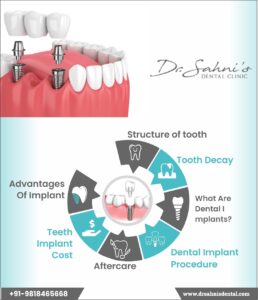Dental implants or tooth implant or teeth implant (if more than one tooth is replaced) is one of the ways of tooth replacement. It consists of a small screw-like device that supports artificial teeth, such as crowns, bridges, or dentures.
Before we begin with detailed information about dental implants, let us briefly look at the structure of teeth and how and why dental decay happens.
Structure of tooth
The visible part of the tooth in your mouth is called the crown, and roots are located in the jaw bone inside the gums. The visible white and hard portion of the tooth is called enamel. Below enamel, a dentin layer is found, and below that, dental pulp, which is a soft portion, is located. This dental pulp is connected to roots inside gums. The main function of teeth is chewing food so it can be gulped down the food pipe.
Tooth decay
Various conditions such as gum infection, bacterial infection on the tooth’s surface, plaque (thin, sticky layer formed by bacteria in the mouth), or tooth grinding lead to thinning of the hard enamel layer of the tooth. This leads to the formation of cavities or tooth decay. A decayed tooth often develops brown-black spots, which, if left unattended, spread. The decay spreads inside tooth layers such as dentin and pulp. This leads to extreme pain, sensitivity, and discomfort. In such cases, you must visit your dentist to save the tooth before the damage is beyond repair or tooth extraction. Tooth decay can cause sensitivity, jaw pain, headache, or even fever.
Now we know that decay can lead to tooth extraction if ignored and not treated in time. Once a tooth is extracted, it creates a gap between teeth. This gap leads to jaw movement and a change in teeth and jaw alignment. This affects your health in many ways, such as a change in a person’s bite or chewing pattern, loss of bone, etc. Therefore, teeth replacement must be done.
What are dental implants?
The dental implant is much like a root anchored inside gums. This anchor supports the artificial tooth, which will be placed on top.
Dental implants consist of three parts, namely dental implant body, dental implant abutment, and abutment fixation screw.
The implant body is surgically placed inside the gum, an implant abutment is fixed with the help abutment fixation screw on top of the implant body, and it generally comes out through the gums. Artificial teeth will then be placed onto this implant abutment. Most dental implant systems are made of titanium or zirconium oxide. Other materials such as gold alloys, cobalt-based alloys, titanium alloys, or ceramic materials are sometimes used.
It can be done for one or more missing teeth. Dental implants can also be either fixed or removable. Removal is generally done when all of the teeth are missing.

Dental implant procedure
Dental implants require one or more surgical procedures. The following steps are followed to evaluate whether you are the right candidate for implants:
- Complete dental exam: dental X-rays and 3D images of your teeth and jaw.
- Review of your medical history: this includes any medical conditions and medications you take, including prescription and over-the-counter drugs and supplements. Also, inform your doctor if you’ve heart disease, diabetes, or any orthopaedic implants in your body.
- Treatment plan: after evaluation by your dentist, you will receive a treatment plan that suits your health, taking into account factors such as how many teeth to replace and the condition of your jawbone and remaining teeth.
- Once your plan is decided, the oral surgeon will make a small cut on the gums and expose the bone. Holes are drilled into the bone where the dental implant body is placed. Sometimes bone grafting is also done at this point.
- After this process of osseointegration begins. This is nothing but a healing process in which the jawbone grows into and unites with the surface of the dental implant. This may take several weeks to months.
- Once the implant has healed, an abutment is placed on the implant. This abutment will anchor the artificial tooth.
- After abutment and gums have fused well together, an impression is taken for the tooth replacement, and the tooth crown or bridge is fixed. There are various options in the material of this artificial (fake) tooth. Generally, the ones that provide the most natural appearance are selected for aesthetic reasons.
Dental implant surgery involves a variety of specialists, such as a doctor who specialises in conditions of the mouth, jaw, and face (oral and maxillofacial surgeon), a dentist specialising in treating structures that support the teeth, such as gums and bones (periodontist), a dentist who designs and fits artificial teeth (prosthodontist), or occasionally an ear, nose, and throat (ENT) specialist.
Dental implant surgery is performed on an outpatient basis and requires several visits with a healing period in between. It is generally performed under local anaesthesia.
Aftercare
You should eat soft food during the entire implant process and protect the area from injuries. Once the implant is completed, you must follow good oral hygiene with regular brushing and flossing. Visit your dentist regularly and avoid damaging habits such as biting onto hard substances, avoid tobacco and caffeine.
Teeth implant cost
There are various brands available for implants. Each tooth replacement cost varies from Rs 20,000 to Rs 50,000 or more.
Advantages of implant
- Restores the chewing pattern and bite
- Restores cosmetic appearance
- It prevents the jawbone from shrinking due to bone loss
- Prevent your face, jawbone, and chin from changing down the line to accommodate the gap from your missing tooth.
- It helps keep adjacent (nearby) teeth and gum stable
- Improves quality of life
Most implants are successful and safe. However, consult your doctor immediately if you experience any discomfort such as bleeding, infection, numbness, or painful implant.
